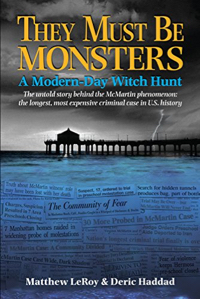Rascals case in brief
In the beginning, in 1989, more than 90 children at the Little Rascals Day Care Center in Edenton, North Carolina, accused a total of 20 adults with 429 instances of sexual abuse over a three-year period. It may have all begun with one parent’s complaint about punishment given her child.
Among the alleged perpetrators: the sheriff and mayor. But prosecutors would charge only Robin Byrum, Darlene Harris, Elizabeth “Betsy” Kelly, Robert “Bob” Kelly, Willard Scott Privott, Shelley Stone and Dawn Wilson – the Edenton 7.
Along with sodomy and beatings, allegations included a baby killed with a handgun, a child being hung upside down from a tree and being set on fire and countless other fantastic incidents involving spaceships, hot air balloons, pirate ships and trained sharks.
By the time prosecutors dropped the last charges in 1997, Little Rascals had become North Carolina’s longest and most costly criminal trial. Prosecutors kept defendants jailed in hopes at least one would turn against their supposed co-conspirators. Remarkably, none did. Another shameful record: Five defendants had to wait longer to face their accusers in court than anyone else in North Carolina history.
Between 1991 and 1997, Ofra Bikel produced three extraordinary episodes on the Little Rascals case for the PBS series “Frontline.” Although “Innocence Lost” did not deter prosecutors, it exposed their tactics and fostered nationwide skepticism and dismay.
With each passing year, the absurdity of the Little Rascals charges has become more obvious. But no admission of error has ever come from prosecutors, police, interviewers or parents. This site is devoted to the issues raised by this case.
On Facebook
Click for earlier Facebook posts archived on this site
Click to go to
Today’s random selection from the Little Rascals Day Care archives….
Click for earlier Facebook posts archived on this site
Click to go to
Today’s random selection from the Little Rascals Day Care archives….
MPD renamed DID – but it’s still bunk
May 31, 2013
“After the DSM-III, often called the ‘Bible’ of psychiatric diagnosis, included (Multiple Personality Disorder) in 1980, thousands of spurious cases emerged in the next two decades, and special psychiatric clinics arose to treat them. Yet faced with evidence of this disastrous epidemic, the DSM-IV did not delete the diagnosis. Instead, the manual renamed it Dissociative Identity Disorder.
“ ‘MPD presented a dilemma for me,’ says (psychiatrist Allen Frances, who oversaw DSM-IV). ‘We took scrupulous pains to present both sides of the controversy as fairly and effectively as possible – even though I believed one side was complete bunk.’ How do you ‘fairly’ argue for a diagnosis you think is complete bunk? Where’s the methodological rigor? Why did it take malpractice suits to close the psychiatric MPD clinics and not the presumed voice of scientific authority, the DSM? Dissociative Identity Disorder remains in the DSM-5.”
– From “How Psychiatry Went Crazy” by Carol Tavris in the Wall Street Journal (May 17, 2013)
“Another disturbing by-product of the MPD diagnosis is the prevalence of alleged repressed memories of satanic ritual abuse. The association of satanic ritual abuse in MPD diagnoses has been attributed to the belief by numerous MPD adherents in the existence of an intergenerational satanic cult conspiracy that has murdered thousands without leaving a trace of evidence.”
– From “Repressed Memory, Multiple Personality Disorder and Satanic Ritual Abuse,” an amicus brief filed in Supreme Court of Georgia, Kahout v. Charter Peachford Behavioral Health System (September 1998)
Moral panics, strange to begin with, also make strange bedfellows

Cohen
June 14, 2018
“America has a long history of episodic moral panics in which self-styled experts, sensationalistic journalists and public officials used emotionally charged language and a barrage of (often distorted) statistics to portray a particular social problem as widespread and urgent….
“The 1980s brought [a] moral panic precipitated by unease about double-income families and the supervision of children by strangers at day-care centers….
“All these scares produced unexpected political alliances. Conservatives concerned with moral purity, law-and-order and Christian values joined forces with feminists worried about victims of sexual trauma and liberals in favor of strong government regulation. When forces from the right and left converge in a moral panic, their causes possess greater appeal to the public. We see this today as women’s rights advocates join the sex-trafficking fight along with the religious right. The result is a runaway train with no real political force left in opposition….”
– From “President Trump signed a new law that aims to fight online sex trafficking. Here’s why that’s bad.” by Sascha Cohen in the Washington Post (April 12)
![]()
‘Satanic ritual abuse’ loses its place in textbook
 April 26, 2013
April 26, 2013
By 1997, when the college textbook “Family Violence Across the Lifespan” was first published, the most grievous excesses of the day-care ritual-abuse panic had passed (although it would be two more years before Little Rascals prosecutors dropped a final, unrelated charge against Bob Kelly).
The authors, social scientists at Pepperdine University, devoted entire sections to “Do Children Fabricate Reports of Child Sexual Abuse?” and “The Satanic Ritual Abuse Controversy.” More on those issues here.
Their approach is thoughtfully skeptical, but they can’t quite bring themselves to call baloney on those peers whose ill-conceived claims ginned up the “controversy” or whose gullibility prolonged it. For example:
“If there is so little evidence confirming the existence of SRA, why do so many perceive the SRA threat to be real? One reason is that… therapists, police officers and child protection authorities, who are often required to attend seminars on current developments in their field, are exposed to SRA ‘experts’…. These seminars tend to employ proselytizing techniques characteristic of organizations seeking recruits. Many well-meaning helping professionals, who are generally motivated by the desire to help abused clients, become convinced of the existence of SRA through these seminars (such as the one at Kill Devil Hills)….”
“Family Violence…” has proved popular enough to justify a third edition (2011), in which all mention of ritual abuse has been removed.
I asked sociologist Robin D. Perrin, one of the authors, to trace his thinking on the subject between editions.
“I suppose one could argue that the ‘Satanic Ritual Abuse’ issue is a bit dated at this point,” he replied, “as the Satanism scare has mostly faded into the sunset. But it is still a fascinating page in history, if nothing else….
“As for our approach on these issues, I think ‘thoughtfully skeptical’ is probably fair. You are correct that we fall far short of an outright denial of the validity of all ritual abuse claims. I am quite certain we are not in position to do that. In fact, given the history of mistreatment of children (both ‘then’ and ‘now’) I have no doubt that ‘ritual’ abuse has occurred (depending on how it is defined, of course).”
Dr. Summit was anything but objective about McMartin
Feb. 8, 2019
Second of two parts
At the core of the recent McMartin expose “They Must Be Monsters: A Modern-Day Witch Hunt” is the authors’ meticulous tracing of how the fantasies of one paranoid schizophrenic mother, Judy Johnson, fostered the longest and most expensive criminal trial in American history.
 But Johnson did not act alone. Toward the end of the book Matthew LeRoy and Deric Haddad recall interviewing psychiatrist Roland Summit in his office and confronting him with evidence that – contrary to his earlier denials — he had been deeply involved not only with supporting Johnson’s bizarre accusations but also with fostering them.
But Johnson did not act alone. Toward the end of the book Matthew LeRoy and Deric Haddad recall interviewing psychiatrist Roland Summit in his office and confronting him with evidence that – contrary to his earlier denials — he had been deeply involved not only with supporting Johnson’s bizarre accusations but also with fostering them.
I asked Haddad what lay behind Summit’s deceit.
“I suspect he was trying to cover up that he had given false testimony under oath,” he said. “He’d testified that they ‘first met’ in February 1984 – but Judy’s own calendars revealed a relationship that went back a year earlier. He may have had an influence on her before she ever even dropped her son off at McMartin.
“So when he looked over her notes, that only we had possession of, he saw that we could prove he’d lied. He got really shaky….”
If he had concerns about his professional reputation, Summit surely had much to be shaky about, including his role in whipping up panic among parents and his insistence that McMartin Preschool sat above a network of abuse-enabling secret tunnels.
![]()











0 CommentsComment on Facebook